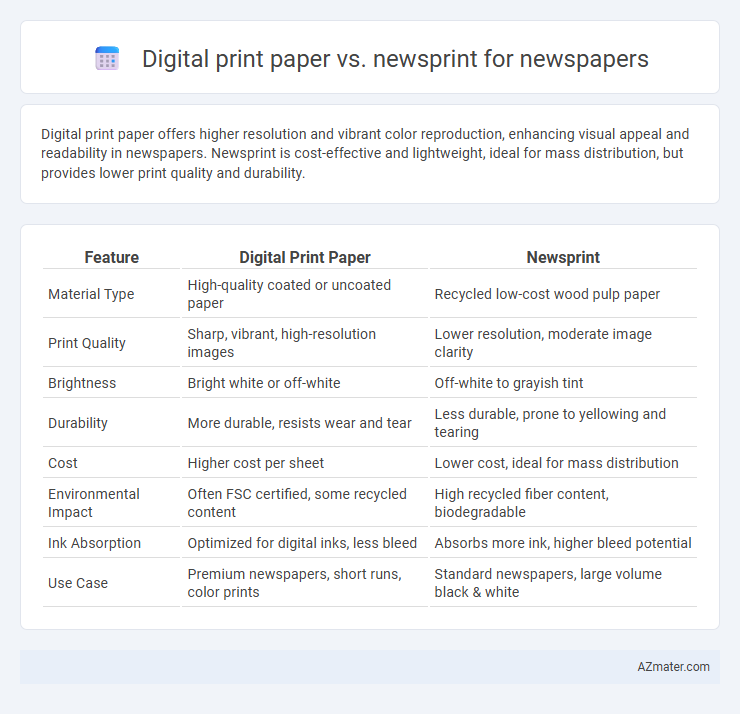Digital print paper offers higher resolution and vibrant color reproduction, enhancing visual appeal and readability in newspapers. Newsprint is cost-effective and lightweight, ideal for mass distribution, but provides lower print quality and durability.
Table of Comparison
| Feature | Digital Print Paper | Newsprint |
|---|---|---|
| Material Type | High-quality coated or uncoated paper | Recycled low-cost wood pulp paper |
| Print Quality | Sharp, vibrant, high-resolution images | Lower resolution, moderate image clarity |
| Brightness | Bright white or off-white | Off-white to grayish tint |
| Durability | More durable, resists wear and tear | Less durable, prone to yellowing and tearing |
| Cost | Higher cost per sheet | Lower cost, ideal for mass distribution |
| Environmental Impact | Often FSC certified, some recycled content | High recycled fiber content, biodegradable |
| Ink Absorption | Optimized for digital inks, less bleed | Absorbs more ink, higher bleed potential |
| Use Case | Premium newspapers, short runs, color prints | Standard newspapers, large volume black & white |
Introduction to Digital Print Paper and Newsprint
Digital print paper is specially coated to enhance ink adhesion and color vibrancy in digital printing processes, offering high-resolution image reproduction and durability suitable for short-run and customized newspaper editions. Newsprint, traditionally used for mass newspaper production, is an uncoated, lightweight paper with high absorbency, designed for economical printing and fast ink drying, though it provides lower print quality and durability. Choosing between digital print paper and newsprint depends on factors like print run length, image quality requirements, cost efficiency, and production speed.
Material Composition and Characteristics
Digital print paper for newspapers typically features a smoother surface with a lightweight, coated or uncoated cellulose fiber base designed for high-resolution inkjet or laser printing, ensuring sharp text and vibrant images. Newsprint consists primarily of low-cost, mechanically pulped wood fibers with a higher lignin content, resulting in a rougher texture and greater absorption that can cause ink bleed but offers economical mass production. While digital print paper enhances print quality and color fidelity, newsprint remains favored for its affordability and recyclability in large-scale newspaper distribution.
Print Quality Comparison
Digital print paper offers superior print quality for newspapers with sharper images, richer colors, and finer detail resolution compared to newsprint, which tends to produce more muted and less precise visuals. Newsprint's porous, lower-density fibers absorb more ink, often resulting in smudging, bleeding, and less vibrant text and graphics. High-quality digital print paper supports advanced ink technologies and higher DPI (dots per inch), ensuring clearer readability and enhanced overall appearance in newspaper production.
Cost Efficiency and Budget Considerations
Digital print paper offers higher cost efficiency for short print runs due to minimal setup costs and reduced waste, making it ideal for targeted newspaper editions with smaller circulations. Newsprint remains more budget-friendly for large-scale newspaper production, benefiting from economies of scale and lower per-unit costs despite its lower print quality. Choosing between digital print paper and newsprint depends primarily on newspaper volume, frequency, and quality requirements aligned with budget constraints.
Environmental Impact and Sustainability
Digital print paper for newspapers offers enhanced environmental benefits by utilizing recycled fibers and lower energy consumption in production, reducing overall carbon footprint compared to traditional newsprint. Newsprint, derived primarily from virgin wood pulp, often involves more intensive water and chemical usage, leading to higher ecological strain and deforestation concerns. Sustainable newspaper publishing increasingly favors digital print paper due to its compatibility with eco-friendly inks and improved recyclability, aligning with circular economy principles.
Durability and Lifespan of Printed Newspapers
Digital print paper typically offers greater durability and a longer lifespan for printed newspapers compared to newsprint, as it is designed to withstand handling and exposure to light without significant degradation. Newsprint, made from low-cost, low-quality pulp, tends to yellow and become brittle over time due to its high acid content, limiting the longevity of printed materials. For archival purposes and extended readability, digital print paper provides superior performance in maintaining print quality and preventing paper deterioration.
Ink Absorption and Color Reproduction
Digital print paper exhibits superior ink absorption properties compared to newsprint, allowing for sharper and more vibrant color reproduction in newspapers. Newsprint, composed of lower-quality fibers and recycled content, absorbs ink more unevenly, resulting in less vivid and often blurry images. The enhanced coating on digital print paper minimizes ink bleed, producing cleaner text and more accurate color tones essential for modern newspaper printing.
Readability and Reader Experience
Digital print paper offers higher print quality and sharper text, enhancing readability with crisp images and consistent ink absorption. Newsprint tends to have lower brightness and absorbency, which can cause fading and smudging, negatively impacting reader experience. The smoother surface and controlled weight of digital print paper reduce eye strain and improve page durability, making it preferable for premium newspapers focused on reader engagement.
Suitability for Modern Printing Technologies
Digital print paper offers superior compatibility with modern printing technologies due to its smooth surface and consistent fiber composition, enabling high-resolution image reproduction and vibrant color output. Newsprint, traditionally designed for offset printing, lacks the necessary brightness and coating, resulting in lower print quality and less durability in digital presses. The enhanced ink absorption and strength of digital print paper make it the preferred choice for contemporary newspapers seeking sharp, clear visuals in fast-paced production environments.
Choosing the Best Paper for Newspaper Publishing
Digital print paper offers higher brightness, sharper image quality, and better durability compared to newsprint, making it ideal for premium newspaper editions where color accuracy and clarity are essential. Newsprint remains the most cost-effective choice due to its lower price and recyclability, suitable for large-volume, daily newspapers prioritizing affordability over print quality. Selecting the best paper for newspaper publishing depends on balancing budget constraints, desired print quality, and environmental considerations.

Infographic: Digital print paper vs Newsprint for Newspaper
 azmater.com
azmater.com